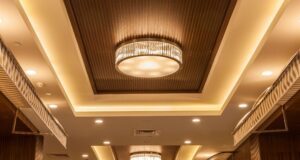Table of Contents:
- What Does The Term “Decorative Lighting” Mean?
- What Is Decorative Lighting In Interior Design?
- What Are Some Other Benefits Of Decorative Lighting?
- What Purpose Does Decorative Lighting Serve?
- When Is The Right Time To Hire A Lighting Designer?
What Does The Term “Decorative Lighting” Mean?
A decorative light fixture has aesthetic value in addition to its functional and technical value. The primary goal of decorative lighting and craft is to enhance the interior design of a room while also providing adequate lighting. It encompasses all forms of traditional lighting, from the floor lamp to the chandelier. Apart from enhancing a room’s artistic value, decorative lighting is also beneficial for creating ambiance. It can illuminate the entire area or concentrate on a specific area to provide lighting for a specific purpose. Nowadays, there are numerous types of decorative lighting, each of which serves a distinct purpose. They can be hardwired or plugged into an outlet or powered by batteries or even solar energy.
What is Decorative Lighting in Interior Design?
Decorative lighting – such as a dramatic pendant, an intriguing wall light, or a feature lamp – accomplishes much more than simply adding visually appealing objects to a room. While our eye is drawn to a large and pleasing pendant over a table, the work of a couple of downlights on either side will significantly improve the light’s quality.
While decorative lighting is necessary, an experienced lighting designer will integrate it with architectural lighting to achieve the best results. To create a soft late-afternoon coziness, simply turn on the decorative lighting while watching TV, reading a book beneath a pretty lamp, or sipping an aperitif. At other times, a more complex combination of lights will be required.
What are Some Other Benefits of Decorative Lighting?
The Element of Layering
Layered lighting is a collection of complementary light sources. Generally, three distinct layers exist Ambient, Task, and Accent. Your primary source of illumination is ambient lighting, such as a chandelier or flush mount.
Task lighting is a more concentrated source of light that makes performing daily tasks easier and safer. When chopping vegetables in the kitchen, under cabinet lighting can assist in bringing the cutting board into focus, preventing you from cutting your finger.
Lighting as a Centerpiece
Apart from serving as a stylish design statement, a decorative light fixture can also serve as the room’s focal point. When using a decorative piece for general illumination, double-check the piece’s dimensions. An oversized chandelier suspended from an 8-foot ceiling in a breakfast nook can appear disproportionate. On the other hand, it might look fantastic in a cathedral-ceilinged entryway. The fixture should cast sufficient light throughout the room to qualify as “ambient.”
Eliminate Shadows
Even if your magnificent decorative fixture does not function well as a source of illumination, do not overlook it! We specialize in one-of-a-kind vintage fixtures that are sure to spark conversation among guests. If you have a room in your home that suffers from shadows or excessive sun glare, a well-placed decorative fixture may be the answer you’ve been looking for.
More for you:
What Purpose Does Decorative Lighting Serve?
Decorative lighting can be used to enhance the beauty of your home or any other indoor or outdoor living space. A well-designed lighting plan is absolutely necessary for a space to be perfect. Decorative lighting was previously reserved for times of festivity, events, and truly special occasions. However, today’s homeowners desire that their living spaces reflect their style and taste. There is no shortage of decorative lighting options available today. Decorative lighting is all about setting the mood and adding interest to a room, for example, by emphasizing specific objects and areas within the room, such as a painting.
Indoor decorative lighting adds personality and style to a room, and it should have a visual impact that instantly defines the owner’s personality. Interior decorative lighting fixtures can be found on the ceiling, such as chandeliers, or on the table, such as lamps. Additionally, it can include wall fixtures such as paintings, medals, and trophies. There are several factors to consider when selecting decorative lighting, including cost-effectiveness, energy efficiency, affordability, and available space.
Outdoor decorative lighting enables you to enjoy your outdoor living space after dark, thereby enhancing your home’s security, safety, and beauty. After dark, decorative lighting transforms your garden.
When is the Right Time to Hire a Lighting Designer?
Call the lighting designers as soon as you and your interior designer or architect have a plan for furniture placement. Your final project will be stronger if we collaborate with an interior designer or architect, as this will allow for the complete integration of fittings into the final design. Occasionally, on larger projects, we will collaborate with a project manager. We want to achieve the best outcome possible for your space, and the earlier we get involved, the fewer tweaks will be required later.




